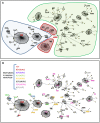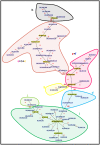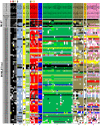Sequence analysis of 96 genomic regions identifies distinct evolutionary lineages within CC156, the largest Streptococcus pneumoniae clonal complex in the MLST database
- PMID: 23593373
- PMCID: PMC3625235
- DOI: 10.1371/journal.pone.0061003
Sequence analysis of 96 genomic regions identifies distinct evolutionary lineages within CC156, the largest Streptococcus pneumoniae clonal complex in the MLST database
Abstract
Multi-Locus Sequence Typing (MLST) of Streptococcus pneumoniae is based on the sequence of seven housekeeping gene fragments. The analysis of MLST allelic profiles by eBURST allows the grouping of genetically related strains into Clonal Complexes (CCs) including those genotypes with a common descent from a predicted ancestor. However, the increasing use of MLST to characterize S. pneumoniae strains has led to the identification of a large number of new Sequence Types (STs) causing the merger of formerly distinct lineages into larger CCs. An example of this is the CC156, displaying a high level of complexity and including strains with allelic profiles differing in all seven of the MLST loci, capsular type and the presence of the Pilus Islet-1 (PI-1). Detailed analysis of the CC156 indicates that the identification of new STs, such as ST4945, induced the merging of formerly distinct clonal complexes. In order to discriminate the strain diversity within CC156, a recently developed typing schema, 96-MLST, was used to analyse 66 strains representative of 41 different STs. Analysis of allelic profiles by hierarchical clustering and a minimum spanning tree identified ten genetically distinct evolutionary lineages. Similar results were obtained by phylogenetic analysis on the concatenated sequences with different methods. The identified lineages are homogenous in capsular type and PI-1 presence. ST4945 strains were unequivocally assigned to one of the lineages. In conclusion, the identification of new STs through an exhaustive analysis of pneumococcal strains from various laboratories has highlighted that potentially unrelated subgroups can be grouped into a single CC by eBURST. The analysis of additional loci, such as those included in the 96-MLST schema, will be necessary to accurately discriminate the clonal evolution of the pneumococcal population.
Conflict of interest statement
Figures





Similar articles
-
An extended multi-locus molecular typing schema for Streptococcus pneumoniae demonstrates that a limited number of capsular switch events is responsible for serotype heterogeneity of closely related strains from different countries.Infect Genet Evol. 2013 Jan;13:151-61. doi: 10.1016/j.meegid.2012.09.008. Epub 2012 Sep 27. Infect Genet Evol. 2013. PMID: 23022733
-
Multiple-locus variable-number tandem-repeat analysis of Streptococcus pneumoniae and comparison with multiple loci sequence typing.BMC Microbiol. 2012 Oct 22;12:241. doi: 10.1186/1471-2180-12-241. BMC Microbiol. 2012. PMID: 23088225 Free PMC article.
-
A multilocus sequence typing scheme for Streptococcus pneumoniae: identification of clones associated with serious invasive disease.Microbiology (Reading). 1998 Nov;144 ( Pt 11):3049-3060. doi: 10.1099/00221287-144-11-3049. Microbiology (Reading). 1998. PMID: 9846740
-
Multilocus sequence typing (MLST) reveals high genetic diversity and clonal population structure of the toxic cyanobacterium Microcystis aeruginosa.Microbiology (Reading). 2007 Nov;153(Pt 11):3695-3703. doi: 10.1099/mic.0.2007/010645-0. Microbiology (Reading). 2007. PMID: 17975077
-
MLST revisited: the gene-by-gene approach to bacterial genomics.Nat Rev Microbiol. 2013 Oct;11(10):728-36. doi: 10.1038/nrmicro3093. Epub 2013 Sep 2. Nat Rev Microbiol. 2013. PMID: 23979428 Free PMC article. Review.
Cited by
-
Clonal expansion of the macrolide resistant ST386 within pneumococcal serotype 6C in France.PLoS One. 2014 Mar 6;9(3):e90935. doi: 10.1371/journal.pone.0090935. eCollection 2014. PLoS One. 2014. PMID: 24603763 Free PMC article.
-
Population Structure of Streptococcus pneumoniae Causing Invasive Disease in Adults in Portugal before PCV13 Availability for Adults: 2008-2011.PLoS One. 2016 May 11;11(5):e0153602. doi: 10.1371/journal.pone.0153602. eCollection 2016. PLoS One. 2016. PMID: 27168156 Free PMC article.
-
Pneumococcal carriage in young children one year after introduction of the 13-valent conjugate vaccine in Italy.PLoS One. 2013 Oct 4;8(10):e76309. doi: 10.1371/journal.pone.0076309. eCollection 2013. PLoS One. 2013. PMID: 24124543 Free PMC article.
-
A Novel Typing Method for Streptococcus pneumoniae Using Selected Surface Proteins.Front Microbiol. 2016 Mar 31;7:420. doi: 10.3389/fmicb.2016.00420. eCollection 2016. Front Microbiol. 2016. PMID: 27064593 Free PMC article.
References
-
- O’Brien KL, Wolfson LJ, Watt JP, Henkle E, oria-Knoll M, et al. (2009) Burden of disease caused by Streptococcus pneumoniae in children younger than 5 years: global estimates. Lancet 374: 893–902. - PubMed
-
- van der Poll T, Opal SM (2009) Pathogenesis, treatment, and prevention of pneumococcal pneumonia. Lancet 374: 1543–1556. - PubMed
-
- Weiser JN (2010) The pneumococcus: why a commensal misbehaves. J Mol Med 88: 97–102 doi:10.1007/s00109-009-0557-x. - DOI - PMC - PubMed
-
- Pelton SI, Leibovitz E (2009) Recent advances in otitis media. Pediatr Infect Dis J 28: S133–S137. - PubMed
MeSH terms
LinkOut - more resources
Full Text Sources
Other Literature Sources
Research Materials
Miscellaneous

